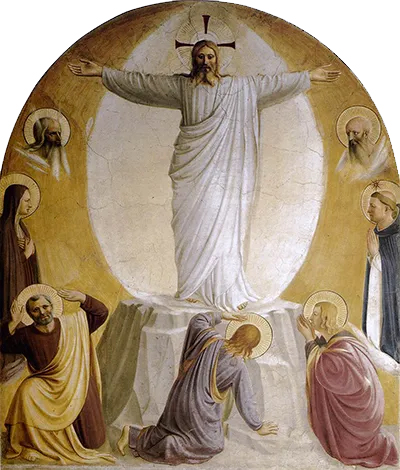Transfiguration is a painting by Italian Early Renaissance artist, Fra Angelico. It is dated to around 1440-1442 and was produced using egg tempera, in line with most artists of that era.
We find here Christ with his arms out open, standing upon a platform which appears to be a natural formation, such as on the tip of a mountain. He is dressed in a stunning white outfit which covers him down to his toes and a white circular shape is found behind him. Surrounding Christ are a number of individuals who look at him from below, which helps to create this impression of power and respect, towards the figure of Christ. They all have halos, coloured with golden paint, which was a common technique used by artists of this period to denote divnity and saint status. Typically artists of this period would help us to identify specific saints by including particular details, such as with them holding an item that related to their own individual lives.
In this depiction Fra Angelico chooses to use two main angles, front on and side on, with less subtlety in between. The figures looking towards Christ are all at one angle or another, which feels slightly strange but is entirely typical of the style of religious art in the Early Renaissance. In reality, crowds would not gather in this manner, and most would be placed at a spectrum of different angles. This fresco can now be found in the Basilica di San Marco, Florence, Italy. The city of Florence played a crucial role in the Italian Renaissance, and retains much of its importance to the art world in the present day thanks to a number of important galleries which display many of the best artworks to derive from that important period. The Renaissance would ultimately spread across encompass different Italian kingdoms over time, bringing in new ideas from local art schools which progressed things onwards once more.
The Transfiguration of Jesus derives from the New Testament. The figure radiates light and glory whilst stood atop a mountain range. The brilliant moment is witnessed by his apostles, Peter, James and John, all of whom may have been added into the scene in front of us here. Many other artists have also taken on this topic, most commonly within the Baroque and Renaissance eras, at which point religious art was at its most dominant within western society. The Transfiguration by Raphael, c. 1520 is perhaps the most famous example of that, though further examples can also be found further afield and in a variety of other styles.




